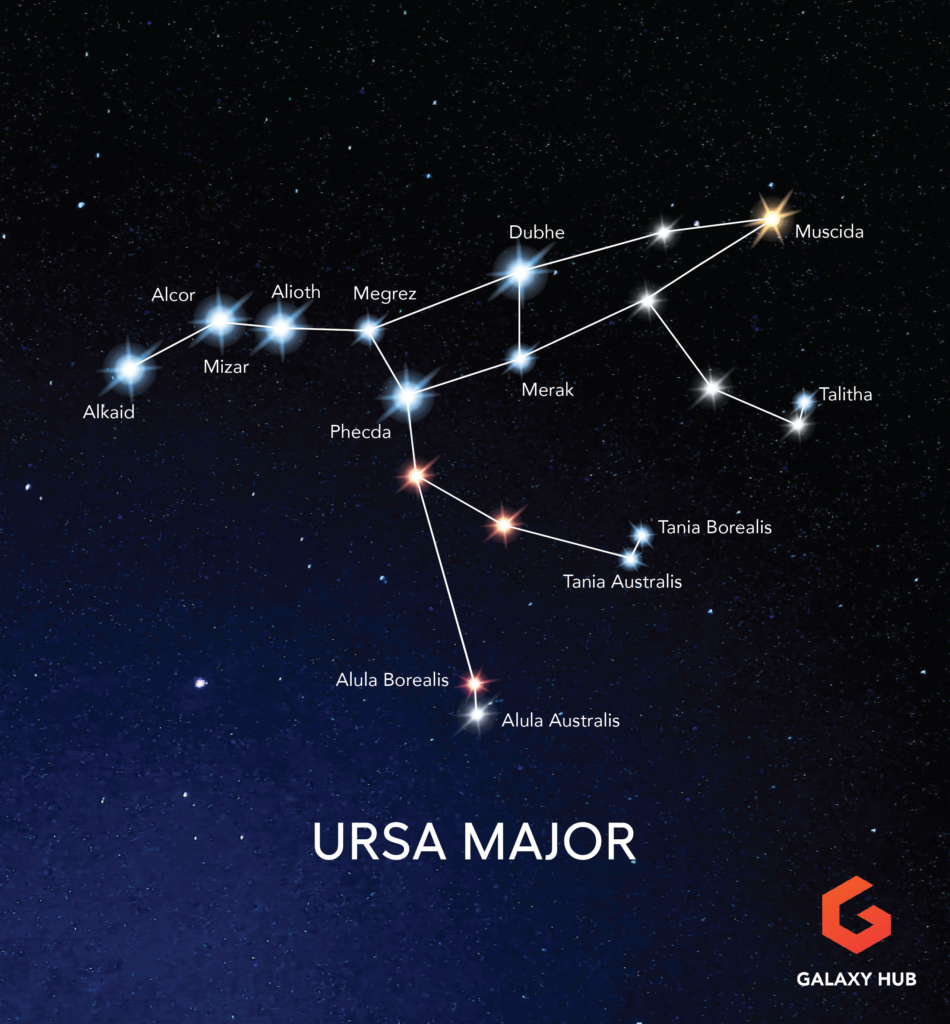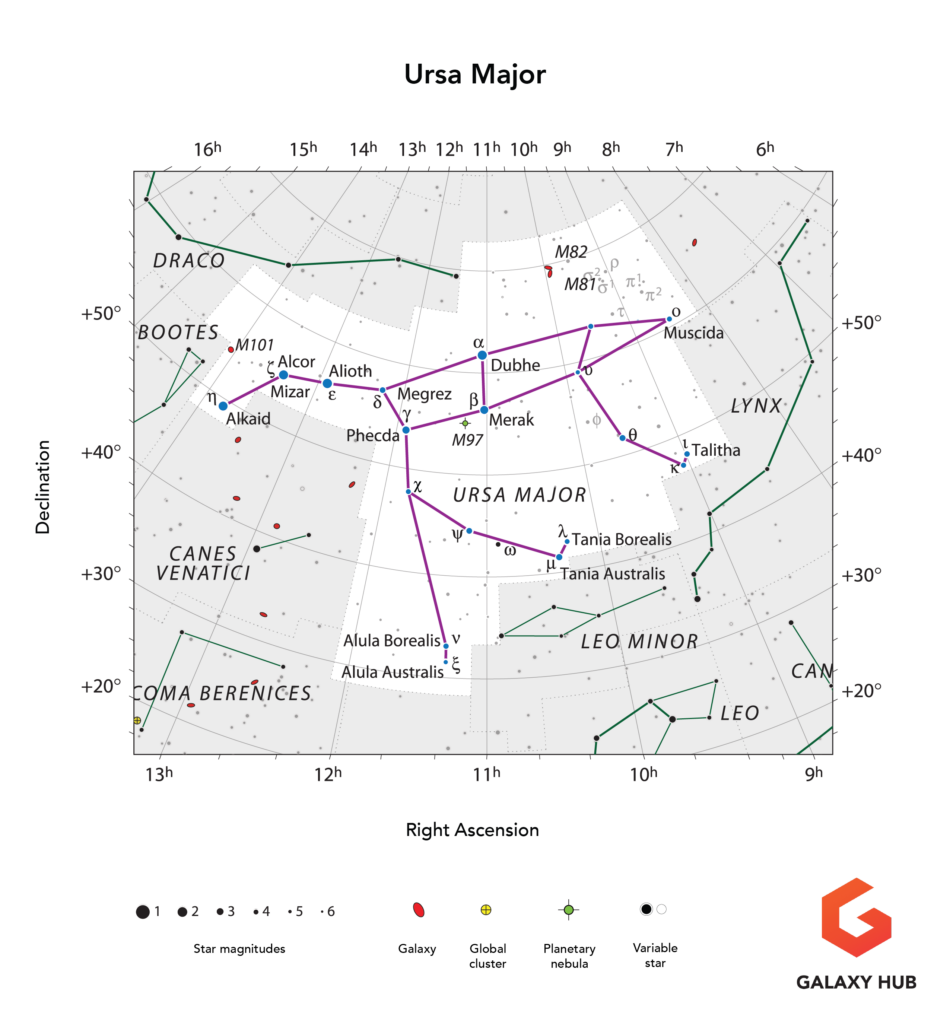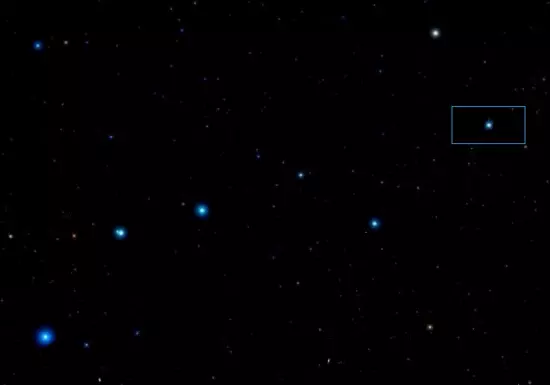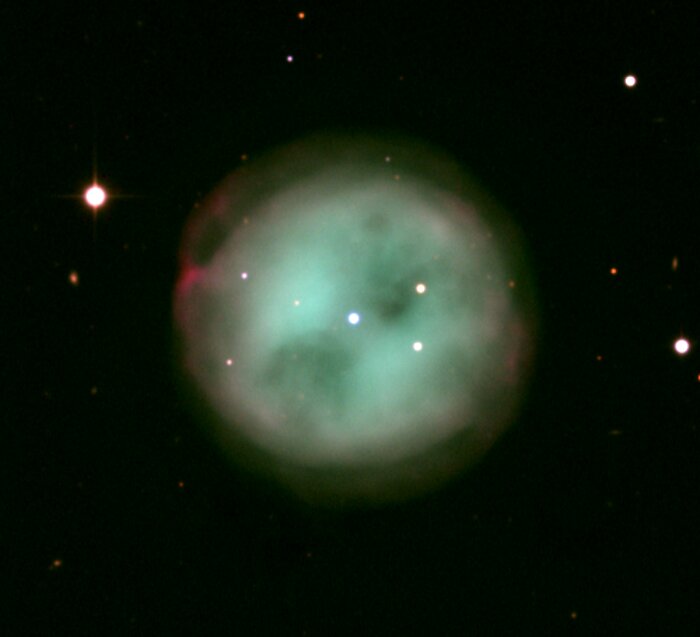
Ursa Major, the Great Bear, is a large, clearly visible constellation visible for the entire northern hemisphere, particularly during the spring and summer. For most stargazers in the northern hemisphere, the constellation is circumpolar and can be seen year-round. The constellation contains numerous stars and deep sky objects for the seasoned astronomer to appreciate, but is also a critical constellation for navigation and is typically one of the first constellations learned by any beginner stargazer.
There are seven bright stars in the Great Bear, making the constellation visible even in light polluted cities. Together, they form an easy to spot asterism called the Big Dipper. The constellation is also home to five Messier objects, some of the first known deep sky objects, which range from the majestic Pinwheel Galaxy to the elusive Owl Nebula.
Ursa Major Key Data
Name
Latin English Pronunciation Genitive Abbreviation
Ursa Major The Great Bear Ur-suh Mey-jer Ursae Majoris UMa
Location
Hemisphere Best Seen R.A. Declination
Northern Early April to Late June 10h 40m 12s +55° 22’ 48”
Features
Area Size Rank # of Messier Objects # of Stars Brighter than Mag 4 Brightest Star
1280 sq. Deg. 3rd 5 20 Dubhe Mag 1.79
Top Ursa Major Facts
The constellation is best seen from Early April to Late June
Ursa Major ranks 3rd in size among all 88 constellations
Ursa Major is one of the earliest recognizable constellations, possibly originating more than 13,000 years ago in the earliest Indo-European cultures.
Ursa Major represents Callisto, a mythological character turned into a bear by Jupiter.
Dubhe, the brightest star in Ursa Major, is the 35th brightest star in the night sky.
Ursa Major can be used to identify the north star, a critical tool for navigation.

Ursa Major in Mythology
Ursa Major is one of the oldest constellations, known to have been created before humans crossed from Asia to the New World at least 13,000 years ago, and can be found in cultures globally.
This predates most known languages.
Most myths involving the constellation take the form of a ‘Cosmic Hunt’, where a hunter chases a four-legged animal and nearly succeeds, but in some twist of luck and fate, the animal is transmuted into a shape in the night sky. Some variation upon this myth can be seen across cultures from Greece all the way to the pre-colonial United States.
Greeks had a version of the Cosmic Hunt where the King of the Gods, Zeus, fell in love with a young nymph named Callisto, a follower of Artemis, goddess of the hunt. Zeus disguised himself as Artemis and seduced Callisto. Callisto eventually became pregnant with a child of Zeus. After discovering Zeus’s extramarital affair, Artemis turned Callisto into a bear in revenge. Callisto then birthed a son, Arcus. Together, the mother and son left.
Eventually, Callisto and Arcus were hunted down by people. Before the two bears could be killed, Zeus intervened and cast the mother and son into the sky as constellations, now seen as Ursa Major and Ursa Minor. As Zeus threw the bears, he held them by the tail; this caused the normally short and stubby tails of the bears to stretch out into the long tails seen in common depictions of the constellation.
There are numerous variations of this myth in Greek and Roman mythology. In some cases, Zeus disguises himself as his wife Hera instead of Artemis. In other cases, Callisto is shot with a silver arrow by Artemis on behalf of Hera.
In Asian mythology, the seven stars in the Big Dipper asterism are typically considered to be representing people of great importance. In Hindu cosmology, this takes the form of 7 great sages who received divine inspiration.
In Native American mythology, Ursa Major is considered to be a bear pursued by either human or wolf hunters.
According to Arabic mythology, the big dipper asterism was referred to as a coffin or ‘bier’ for Al-Nash, who was slain by the pole-star Polaris. The three stars in the handle of the dipper are the daughters of Al-Na’ash; the double-star Mizar is a woman carrying a child or walking with her husband in different versions of the story.

Ursa Major in History
Prior to written language, Ursa Major was known to early humans as early as 13,000 years ago. This prehistoric origin means that the constellation is known to numerous cultures around the world, rather than originating from a single known source. Evidence of this ancient origin can be traced to the shared myths of the Native American and Greek cultures.
Ursa Major is one of the original 48 constellations listed in the 2nd century by the Greek astronomer Ptolemy, in his great work, the Almagest. His name for the constellation was Arktos Megale, or large bear. As such, it has been in existence for thousands of years and has changed little in the intervening time.
In some asterisms, Ursa Major is seen as a plow, chariot, wagon, and even a drawn bow.
When and How to See Ursa Major
Observers in the Northern Hemisphere will have an easy time identifying this large and prominent constellation. For mid-northern observers, the constellation can appear anywhere from the north horizon to almost overhead. Ursa Major can always be found within ~30 degrees of the North Star, Polaris.
Southern Hemisphere observers will not be able to see the constellation easily, as it will only be visible briefly above the horizon in the spring. Observers south of the tropics are unfortunately out of luck when seeking out Ursa Major, as the constellation will not rise above the horizon.
Learning Ursa Major is typically the first step in learning the night sky, because spotting Ursa Major is easy! Simply look north on a clear night, and you should see a constellation the size of your hand with the unmistakable curve of a 7-starred spoon or ladle. In the early winter, the spoon will appear to rest on the horizon; in the spring, the spoon will appear to be tipping its contents out over the northern star.
You can easily trace out from Ursa Major to other constellations in the night sky, star hopping from one constellation to the next. The North Star can be found by following the last two stars of the dipper’s spoon out of the scoop; they form an almost perfect line. You can also trace the other direction, and encounter Vega to the south.

Ursa Major’s Notable Stars
Bayer/Flamsteed Designation Name (s) Mag R.A. Dec. Distance (LY) Notes
Alpha / 50 Dubhe 1.8 11h 03m 43s +61° 45’ 03” 123 Ursa Major’s brightest star
Beta / 48 Merak 2.4 11h 01m 50s +56° 22’ 07” 80 Infrared emitter
Gamma / 64 Phecda 2.4 11h 53m 50s +53° 41’ 41” 83 Strong spectral emission lines make Phecda a useful target for spectrometers
Delta / 69 Megrez 3.3 12h 15m 25s +57° 01’ 57” 80 The base of the bear’s tail
Epsilon / 77 Alioth 1.8 12h 54m 02s +55° 57’ 35” 83 One of the 57 navigational stars
Zeta / 79 Mizar 3.9 13h 23m 55s +54° 55’ 31” 83 First telescopic binary
Eta / 85 Alkaid 1.9 14h 37m 42s +49° 18’ 47” 104 Tip of the bear’s tail
Alpha Ursae Majoris (Dubhe)
Dubhe (pronounced with a silent h) forms the tip of the dipper in the Big Dipper asterism, making it incredibly easy to spot.
Most astronomers know Dubhe as a ‘pointer star’, used to quickly find Polaris when light conditions make the dim North Star harder to spot. Dubhe is a navigational star, used by sailors to determine their position on the globe.
Dubhe’s name originates in Arabic, and means ‘the back of the bear’. Like most stars in Ursa Major, Dubhe’s name refers to the anatomy of the bear in its constellation.
However, this bright star has had many names around the world. Egyptians would refer to Dubhe as ‘Ak’, after the great eye, and worshipers of Horus used the location of the star to align temple walls thousands of years ago.
On the other side of Asia, the Hindus called Dubhe ‘Kratu’, named for one of the mind-children of the creator deity Brahma. This mythological character was known for having 60,000 children, and may have shared a cognate name with the Greek mythological character ‘Kratos’.
Dubhe is the state star of Utah, recognized on the 1996 Centennial Year for being 100 light years away. This means that the starlight we see from Dubhe is 100 years old.
While Dubhe may hold the alpha title in Ursa Major, it isn’t actually the brightest star! That distinction falls on Alioth, which is ~2% brighter.
While the rest of the Ursa Major constellation is a single group of stars moving through the sky, Dubhe isn’t attached to this moving group.
Dubhe is a spectroscopic binary star system, with a separation of only 23 AU and a period of 44 years. The larger star, alpha ursae majoris A, is an orange giant around 3.4 solar masses and has left the main sequence, while the companion alpha ursae majoris B is a main sequence star of ~1.6 solar masses.

Merak is the second star in the spoon of the big dipper asterism, after Dubhe. With a visual magnitude of +2.4, the star can be spotted naked-eye from nearly any level of light pollution. Merak is the second pointer star in the big dipper asterism, just behind Dubhe.
Merak’s name originates from Arabic, al-maraqq, translating to ‘the loins of the bear’. This name refers to the anatomy of the bear in the constellation. Another cultural name for beta ursae majoris is Pulaha, one of the Hindu sages and son of Brahma. The Greeks may have known the star by the name Helike, and featured it in a myth of Persephone and Demeter.
According to Greek mythology, Persephone was the daughter of the gods Zeus and Demeter. Zeus permitted the god of the underworld, Hades, to have her in marriage; Demeter was not made aware of this agreement.
Hades captured Persephone while she was picking flowers, and took her to the underworld unwillingly. This is typically referred to as the ‘rape of Persephone’, and was famously depicted by the artist Ruben.
Unable to find Persephone, Demeter asked Helike where her daughter had gone. Helike told her that she had seen nothing, but that Demeter should ask Helios and Hekate, who would see it had it happened during the day.
In the end, Demeter and Hades reach an agreement that Persephone would spend 6 months with each per year; this was used to explain seasons.
Merak is a member of the Ursa Major Moving Group, traveling with several other prominent stars in the same direction.
Unlike many other stars, Merak has a circumstellar debris disk that occasionally blocks light. This debris disk is nearly 47 AU in radius. Merak itself is a subgiant star, and is far brighter than the Sun.
Gamma Ursae Majoris (Phecda)
Phecda is the third star in the big dipper asterism, after Merak. At +2.4 magnitudes, this star is clear in almost any light conditions.
Like most stars, Phecda’s name originates in Arabic; fakhth al-dubb, meaning ‘the thigh of the bear’ in reference to the constellation itself. In Hindu mythology, this star is named Pulastya, one of the seven sages.
Phecda is a member of the Ursa Major moving group like Merak, and is a binary system with a separation of .460” and orbital period of ~20.5 years. Phecda itself is about 2.9 times the size of the sun, while its smaller companion is only .79 times the size of the sun.
Delta Ursae Majoris (Megrez)
Megrez is the fourth star of the dipper, after Phecda. Megrez is the dimmest star in the big dipper asterism, at only +3.3 magnitudes. This star is still usually visible in bright cities, especially when you already know where to look by seeing the rest of the dipper stars.
Following a familiar pattern, Megrez gets its name from Arabic; al-maghriz, or ‘the base of the tail’. In Hindu mythology, the star is known as Atri, one of the seven great sages.
Megrez is a member of the Ursa Major moving group, and is known to have a debris disk orbiting the star at 16 AU; this causes the star to be very bright in the infrared wavelengths. Megrez may be a variable star, meaning that its brightness changes over time.
Epsilon Ursae Majoris (Alioth)
Alioth is the fifth star of the big dipper asterism, after Megrez. Alioth is the brightest star in the Ursa Major constellation at +1.7 magnitudes, and is a navigational star like Dubhe.
Unlike the previous stars, while Alioth’s name is Arabic in origin, it does not refer to the bear constellation. The name is thought to come from a misinterpretation of alyat al-hamal, or ‘the tail of the fat sheep’, which is actually the Pleiades!
The Hindus know this star by its title Añgiras, one of the seven great sages.
Alioth is a variable star of the α2 Canum Venaticorum variety. This means that rather than the entire star getting brighter and dimmer, some of the spectral lines of the star change daily. Every 5.1 days, the star spectrum undergoes a spectrum cycle. For some time, it was thought that this variability was caused by a close binary companion, but modern searches have turned up no companions.
Today, the variability is thought to be caused by elements getting sorted in the star by the combination of a strong magnetic field and off-axis spin.
Alioth is a member of the Ursa Major moving group.
Zeta Ursae Majoris (Mizar)
Mizar is a well known visual binary star in Ursa Major, and is the 6th star in the big dipper asterism after Alioth. Mizar is a +2 magnitude star and is visible from nearly any light conditions.
Mizar’s Arabic name is miʼzar, meaning ‘apron’ or ‘covering’. According to the IAU, Mizar only applies to the brighter component of the star system, but in popular use, Mizar refers to the entire system.
According to Hindu culture, Mizar is known as Vashistha, one of the seven sages.
In Arabic mythology, Mizar is one of the daughters following Al-Na’ash, and is carrying her child Alcor.
Mizar is an important star in astronomy history, as it is the first well-known binary star. Mizar has a smaller companion star, Alcor, only 14 arcseconds away. Together, the stars are known as Zeta A and Zeta B. This star system was known historically, and was first observed through a telescope by Galileo in 1617. Galileo produced accurate descriptions of the system in his journal.
A few hundred years later, observations of Mizar by Antonia Maury in 1890 with a spectrometer revealed that the star was a spectroscopic binary. This makes Mizar not only the first binary star discovered, but also the first spectroscopic binary star. The two stars, Zeta Aa and Zeta Ab, are roughly the same size and have a 20 day orbital period.
Alcor (Zeta B) is also a spectroscopic binary with Zeta Ba and Bb orbiting each other once every 175 years.
Mizar is a member of the Ursa Major moving group, and is today known as a quadruple star system.
Eta Ursae Majoris (Alkaid)
Alkaid is the last star of the big dipper asterism, at the end of the tail. With a magnitude of 1.8, Alkaid is visible in almost all lighting conditions.
Alkaid gets its name from the Arabic name qā’id bināt naʿsh, meaning ‘the leader of the daughters of the bier’. This refers to the story of Al-Na’ash, who sits in the coffin made of Dubhe, Merak, Phecda, and Megrez.
In Hindu cosmology, Alkaid is known as Marīci, one of the seven sages.
Alkaid is not a member of the Ursa Major moving group.
Ursa Major’s Deep Sky Objects
Object Name(s) Type Mag R.A. Dec. Distance (LY) Min. Equipment
M81 Bode’s Galaxy Grand Design Spiral Galaxy 7 09h 03m 43s +61° 55’ 33” 96,000 Small Telescope
M82 Cigar Galaxy Starburst Galaxy 8.4 09h 55m 02s +69° 40’ 47” 11,400,000 Small Telescope
M97 Owl Nebula Planetary Nebula 9.9 11h 14m 47s +55° 01’ 08” 2,000 Small Telescope
M101 Pinwheel Galaxy Face-On Spiral Galaxy 7.9 14h 03m 12s +54° 20’ 57” 20,900,000 Small Telescope
NGC 2787 N/A Lenticular Barred Galaxy 11.7 09h 19m 18s +61° 45’ 03” 24,000,000 Small Astrophotography Setup
NGC 2950 N/A Lenticular Galaxy 11.9 09h 42m 35s +58° 51’ 04” 49,000,000 Small Astrophotography Setup
NGC 3079 Garland Galaxy Barred Spiral Galaxy 11.5 10h 01m 57s +55° 40’ 47” 50,000,000 Small Astrophotography Setup
NGC 3310 N/A Grand Design Spiral Galaxy 11.2 10h 38m 45s +53° 30’ 11” 34,000,000 Small Astrophotography Setup
NGC 4013 N/A Edge-On Barred Spiral Galaxy 12.1 11h 58m 31s +43° 46’ 50” 60,000,000 Small Astrophotography Setup
Nebulae
The Owl Nebula (Planetary Nebula)
The Owl Nebula, known as M97 (Messier 97) is a dim planetary nebula in Ursa Major that is considered a challenge by most observers, but is an essential part of any Messier marathon.
To see the Owl Nebula, point a small telescope or binoculars at Merak, and go ~1/6th of the way to Phecda. You will see a small, gray sphere. If you look closely, you may see patterns in the surface of the sphere. To enhance the view, use an astrophotography setup. The Owl Nebula should pop into view nicely!
Eight thousand years ago, this nebula was a red giant star at the end of its life. The unknown star exploded into a supernova, creating the gasses we see in the nebula today. At the center of the sphere of expanding gasses, a white dwarf is all that remains of a former star! This dwarf, at more than 100,000 K, will cool slowly while the shell of gasses disappears into space.
The nebula was seen by Charles Messier in 1781 as he searched Ursa Major for comets. He remarked, “Nebula in the great Bear, near Beta: It is difficult to see… its light is faint, without a star.” Messier was simply unable to see the dwarf at the center of the nebula with his equipment at the time; a 7.5 inch 104x Gregorian reflector.

Galaxies
Ursa Major has a plethora of galaxies!
Since Ursa Major is away from the Milky Way galactic plane, we can see out to the far edges of the universe. This is the main reason that the Hubble Deep Field was taken in Ursa Major.
The brightest galaxies you can see in Ursa Major are the Cigar galaxy and Bode’s Galaxy (M82 and M81, respectively). These galaxies are right next to each other, and can be spotted through a small telescope by following Phecda to Dubhe and continuing the same distance.
Both galaxies can be captured in the same image if you are doing astrophotography with a fast telescope, although a longer focal length is more at home for galactic astrophotography.
M81 is a beautiful grand design spiral galaxy, with well defined arms and a bright core. In 1774, Johann Bode discovered the galaxy; Messier put it into his catalog following the discovery in 1774. The galaxy is home to a supermassive black hole, and is thought to be responsible for a fast radio burst.

M82 is a starburst galaxy undergoing rapid, intense star formation due to gravitational interactions with M81. Bode discovered M82 at the same time as M81, remarking that the object he saw was “very pale and of elongated shape”.
The object was added to Messier’s catalog later, and was found to be a galaxy by later astronomers in the 1800s. M82’s core is very active, emitting in visible, infrared, radio, and x-ray, likely caused by the supermassive black hole at the center of the galaxy interacting with nearby gasses and stars.

M81 and M82 are only a few members of the larger M81 galactic group, a cluster of galaxies including M81, NGC 2403, M82, NGC 4236, NGC 3077, and NGC 2366 among others. These galaxies are all moving through space together, and form the closest galactic group to the Local Group.
Possibly the second most picturesque galaxy in the northern hemisphere, second to Andromeda, is M101. Commonly referred to as the Pinwheel galaxy, M101 is a face-on spiral galaxy 21 million light years away. Pierre Méchain was the first astronomer to spot the galaxy, calling it a nebula without stars.

With a small telescope, you can starhop to M101 easily. Starting from Alioth, slew pass Mizar and keep going the same distance. The Pinwheel galaxy will show up as a dim fuzzy blob in the eyepiece of a small telescope. Low magnification eyepieces will show the galaxy better than high magnification eyepieces.
Larger telescopes will resolve the spiral structure in dark skies, and with astrophotography equipment you can take excellent pictures of the spiral arms and galactic structure. The face-on structure of M101 results in somewhat regular supernova detections in the galaxy, with four notable supernovae since the year 1900.
Like M81, M101 has a galactic group of faint galaxies around it. NGC 5204, NGC 5474, NGC 5477, NGC 5585, UGC 8837, and UGC 9405 are all moving together and interacting gravitationally, causing additional star formation in the spiral arms of M101.
From there, a number of other faint galaxies can be detected using astrophotography. NGC 2787, 2950, 3079, 3310, and 4013 can each be seen around the constellation by a determined amateur with dark, clear skies. Expect to capture at least 5 minutes of light to see these galaxies, and use frame stacking and calibration frames if you wish to capture detail. If done right, you can get spectacular results with a modest setup and a few hours of integration time.

